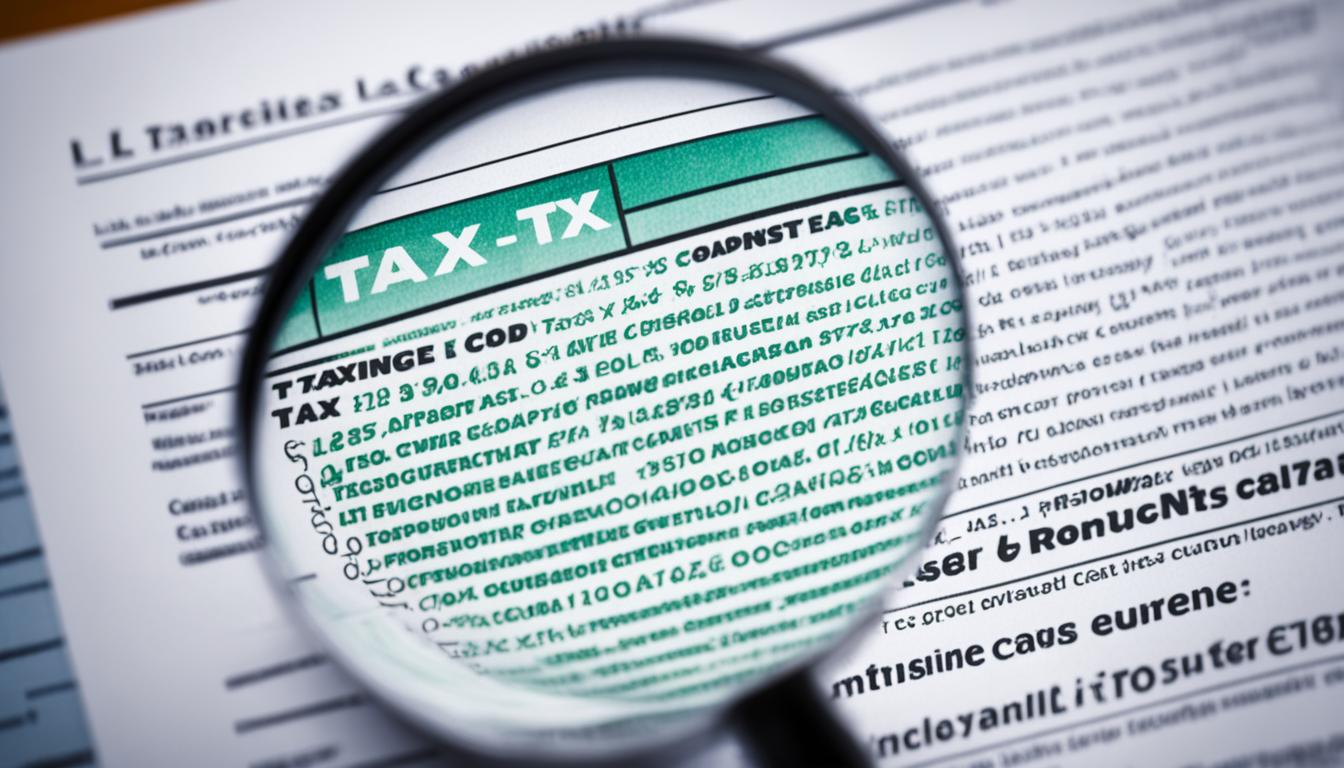Welcome to our comprehensive guide on tax code L in the United Kingdom. If you’ve ever wondered what the tax code L means or if you’re looking for an explanation of tax codes, you’ve come to the right place. In this article, we will provide you with all the information you need to understand tax code L and any recent changes that might affect you.
A tax code is a combination of numbers and letters given to individuals to indicate how much Income Tax and National Insurance they should pay. Tax code L is one of the most common tax codes in the UK and it holds a lot of significance for employees and pensioners. So, let’s dive into the details and discover what tax code L is all about.
Stay tuned for the upcoming sections where we will explore who receives a tax code, how tax codes are determined, and what the numbers in the tax code represent. We will also highlight some common tax codes and help you understand how to make the most of your tax code. Whether you’re an employee or a pensioner, understanding your tax code is essential for your financial well-being. Let’s navigate the world of tax codes together!
Who Receives a Tax Code?
When it comes to tax codes, who receives one and why? Let’s dive into the key categories of individuals who are assigned tax codes:
1. Employees
Anyone employed or paid through PAYE (Pay As You Earn) will receive a tax code from their employer, which is provided by HMRC (Her Majesty’s Revenue and Customs). This includes individuals working for companies or organizations.
2. Pensioners
Pensioners whose pension is their only source of income are also assigned a tax code. Whether they receive a state pension or private pension, their tax code will indicate how much Income Tax and National Insurance should be deducted from their pension earnings.
3. Sole Traders and Self-Employed Individuals
Sole traders and self-employed individuals, who do not pay themselves through PAYE, do not have a tax code. Instead, they must manage their taxes through self-assessment, where they calculate and report their income and expenses to HMRC.
It’s important to note that tax codes are specific to individuals and are not transferable. Each person receives their unique tax code based on their circumstances and sources of income.
Now that we know who receives a tax code, let’s explore how tax codes are determined.

| Category | Who Receives a Tax Code? |
|---|---|
| Employees | Yes |
| Pensioners | Yes |
| Sole Traders and Self-Employed Individuals | No |
How Tax Codes are Determined?
Tax codes in the UK are determined by several factors that take into account an individual’s tax situation. The primary factor influencing tax codes is the Personal Allowance, which is the amount of income an individual can earn tax-free in a tax year. Other factors that can affect tax codes include additional income from another job, taxable benefits received, and any outstanding taxes owed from previous years.
The Personal Allowance is determined by HM Revenue and Customs (HMRC) and is set annually. It is usually increased each year to account for inflation and changes in economic conditions. The current tax year, for example, has a Personal Allowance of £12,570.
Individuals who have additional sources of income besides their main job may have a different tax code that reflects this. The tax code takes into account the total income earned from all sources to calculate the amount of tax that needs to be deducted.
Taxable benefits received, such as company-provided cars or private medical insurance, can also impact tax codes. These benefits are considered part of an individual’s income and are subject to tax calculations.
Outstanding taxes from previous years can also affect tax codes. If an individual has underpaid taxes from previous years, HMRC may adjust their tax code to collect the outstanding amount. This adjustment ensures that individuals do not avoid paying their full tax liability by spreading the payments over multiple years.
To inform individuals about any changes in their tax code, HMRC issues tax coding notices annually. These notices explain why a tax code may be different from the standard code and provide detailed instructions on how the tax code was determined.
Additionally, individuals can use the government’s official website and tax code calculators to find out what their tax code should be. These online tools take into account various factors, such as income, benefits, and previous tax liabilities, to calculate the appropriate tax code.
If an individual believes that their tax code is incorrect, they should contact HMRC directly to discuss their situation and request an amended tax code. It is essential to ensure that tax codes are accurate to avoid overpaying or underpaying taxes and to comply with tax regulations.
Factors Affecting Tax Codes
- Personal Allowance
- Additional income from another job
- Taxable benefits received
- Outstanding taxes from previous years

| Factors | Impact on Tax Codes |
|---|---|
| Personal Allowance | Determines the tax-free income an individual is entitled to |
| Additional income | Affects the overall tax calculation by considering all sources of income |
| Taxable benefits | Included in the individual’s income and subject to tax calculations |
| Outstanding taxes | Adjustments made to collect unpaid taxes from previous years |
Understanding the Tax Code L
The number in the tax code plays a crucial role in determining an employee’s tax obligations. It is the figure that precedes the letter in the tax code and represents the total amount of income an employee can earn before they are subject to tax.
When deciphering the number in the tax code, it is important to note that it is usually multiplied by 10 to calculate the tax-free Personal Allowance. Let’s take an example: if the tax code is 1257L, the number 1257 indicates that the individual can earn £12,570 before tax applies.
The letter in the tax code provides additional meaning and context to the tax situation. For instance, the letter L indicates the standard Personal Allowance, which is the amount an individual can earn tax-free. On the other hand, the letter K is used for individuals whose deductions from previous years exceed their Personal Allowance.
Understanding the number in the tax code is vital because it helps individuals gauge their tax liability and plan their finances accordingly. By knowing the figure that represents their tax-free earnings, employees can have a clearer understanding of their take-home pay and effectively manage their budgets.
Tax Code Letters and Their Meanings
| Tax Code Letter | Meaning |
|---|---|
| L | Standard Personal Allowance |
| K | Deductions from previous years exceed Personal Allowance |
| S | Income or pension taxed at the Scottish rate |
| T | Income is taxed more than the basic rate |
| 0T | No Personal Allowance, all income is taxed |

By familiarizing themselves with the number in their tax code, individuals can better understand their tax calculations and make informed financial decisions. It is important to regularly review your tax code and contact HMRC if you believe it to be incorrect to ensure accurate tax assessments and avoid any potential tax-related complications.
Common UK Tax Codes
Understanding the various tax codes used in the UK can help individuals navigate the complex world of taxation. Here, we explore some of the most common tax codes and their significance.
Tax Code 1250L
In the 2020/21 tax year, one of the most prevalent tax codes for employees with a single job is 1250L. This tax code represents the standard Personal Allowance of £12,500, which is the amount an individual can earn tax-free within a tax year.
Tax Code 1257L
For the 2021/22 tax year, the most frequently used tax code is 1257L. This code reflects the increased Personal Allowance of £12,570, providing individuals with a slightly higher tax-free earning threshold.
Tax Code Variations
While the aforementioned tax codes are the most common, variations do exist. Examples include 1256L and 1283L. These variations are often assigned to individuals who are eligible for tax relief due to job-related expenses. Consequently, the Personal Allowance may be higher for individuals with such tax codes, potentially resulting in tax rebates.

Tax Code Summary
Understanding the different tax codes in the UK is essential for individuals to comprehend their tax obligations and entitlements. Common tax codes such as 1250L and 1257L indicate the standard tax-free allowances for different tax years. Variations in tax codes like 1256L and 1283L can lead to higher Personal Allowances and potential tax rebates. By staying informed about tax codes, individuals can optimize their financial planning and ensure compliance with tax regulations.
| Tax Code | Year | Personal Allowance |
|---|---|---|
| 1250L | 2020/21 | £12,500 |
| 1257L | 2021/22 | £12,570 |
| 1256L | Varied | Tax Relief for Job-Related Expenses |
| 1283L | Varied | Tax Relief for Job-Related Expenses |
Conclusion
Understanding your tax code, especially the common tax code L, is crucial for ensuring that you are paying the correct amount of income tax. The tax code L indicates that you are entitled to the standard tax-free Personal Allowance, which is £12,570 for the tax year 2021/22. By familiarizing yourself with your tax code and keeping it up to date, you can optimize your tax position effectively and avoid any unexpected tax bills.
It is important to review your tax code regularly and contact HMRC if you believe it is incorrect. An incorrect tax code can result in overpayment or underpayment of tax, affecting your financial situation. Staying informed about changes in tax legislation and personal circumstances that may affect your tax code is essential. Take advantage of available resources, such as the government website and tax code calculators, to ensure that you have a clear understanding of your tax code.
By taking the time to understand your tax code and proactively managing it, you can navigate the complexities of the tax system smoothly. Remember, your tax code is a crucial aspect of your financial responsibilities, and staying informed will help you make informed decisions and ensure that you are paying the correct amount of tax.




















No Comments
Leave a comment Cancel